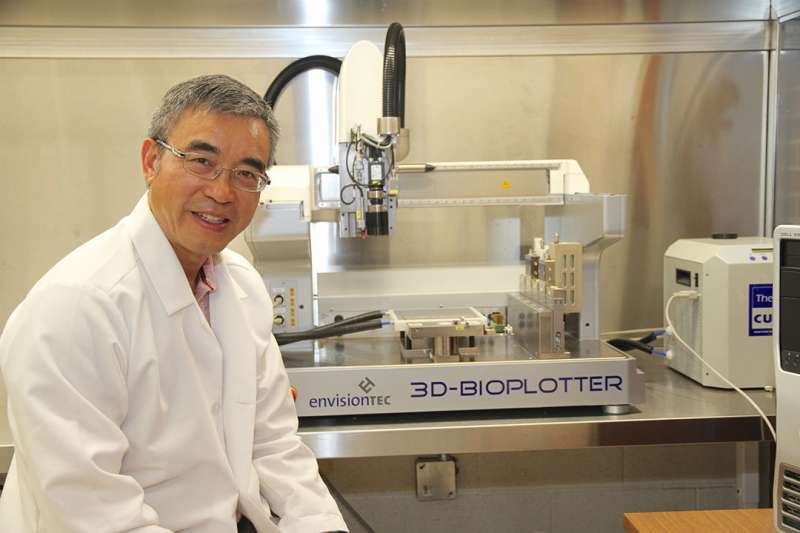Professor Daniel Chen of the College of Engineering, with the 3D-Bioplotter in the U of S Bio-fabrication Laboratory. Credit: James Shewaga
Strand by strand, and layer by layer, Daniel Chen's research team is inching closer to repairing and rebuilding bones with the use of 3-D printing technology.
A leader in the exciting and emerging field of tissue engineering, Chen's interdisciplinary research team is working with the 3-D-Bioplotter (printer) in the University of Saskatchewan's Bio-fabrication Laboratory to develop new ways to help restore bone function in individuals who have suffered serious trauma, infection, disease or defects.
"I am always excited about this kind of research," said Chen, a professor of mechanical engineering and leader of the Tissue Engineering Research Group at the U of S. "Before this we did research to repair peripheral nerves and spinal cords and cartilage as well as treat heart attacks. So, we have done some research in those applications and achieved some success and we have found that we have strengths in this area in this university. So, we are confident going ahead with this kind of research."
Chen was one of 12 U of S researchers who were awarded Collaborative Innovation Development grants in March from the Saskatchewan Health Research Foundation, receiving $50,000 in funding over the next 18 months for his new project. Chen's team is bioengineering bone substitutes (known as scaffolds) and employing the world-class imaging technology of Canada's only synchrotron in the Canadian Light Source facility on the U of S campus to track the effectiveness of their new bone regeneration strategies.
Previous efforts in this pioneering field of research haven't been successful in providing long-term or permanent stable solutions to restoring bone function, particularly for large bone defects and damage, since bone tissue has a limited capacity to repair itself. Chen's team is looking to bioengineer artificial bone structures to be implanted into the body to essentially serving as a template or framework to help bone regeneration.
"What we are going to do is unique in bone tissue engineering, using 3-D printing and nano-biotechnology to develop new scaffold types for bone repair," said Chen. "The other research goal is to show that we can successfully use synchrotron imaging as a new non-invasive method to monitor the bone regeneration. Since our research goal is to eventually use this for a human being, we need a non-invasive method. And with the synchrotron, we can view it in great detail, so we don't need to take this sample out of the body to see how it is regenerating."
Chen said the U of S is perfectly positioned to conduct this type of leading-edge research, combining one-of-a-kind facilities like the Canadian Light Source with the university's proven track record of success in interdisciplinary collaborative research endeavours.
"I come from an engineer's point of view, to design and build, and then I need to collaborate with researchers in life sciences and veterinary medicine, because this kind of research requires an interdisciplinary approach," said Chen, who earned his Ph.D. in 2002 at the U of S and began his teaching and research career here a year later in the College of Engineering. "In this project we tried to combine the strengths of this university together, which includes strengths in 3-D printing and strengths in life sciences and veterinary medicine, as well as strengths in imaging technology by using the synchrotron facilities. And that is the strength of this university."
Chen's team is at the forefront of this fascinating field of research, focused on improving the quality of life for people in this province and beyond, who need to restore bone function. If the pilot project proves promising with animal subjects, Chen will look to replicate the success with human patients at some point.
How soon could that happen? "That is a good question," said Chen, who earlier this year was named a Fellow of the Engineering Institute of Canada, for his exceptional contributions to engineering in this country. "When we talk about tissue engineering, the first question is when it can be translated into a human being? But it's a research process that takes time to follow the proper steps and it will very much depend on how the research is going. So, we are going to do this preliminary study and if the results are meaningful, then we will look to take the next steps toward comprehensive studies on bone tissue engineering."
Provided by University of Saskatchewan
























